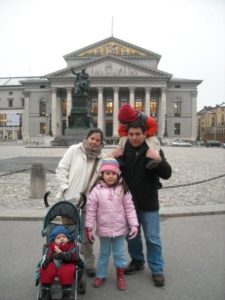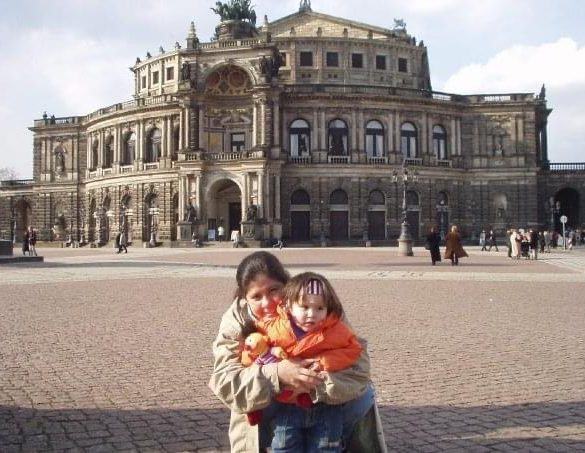The journey of immigration and creating more than one home.
Editor’s Note: The writer of this story, Daniela Morales, is also a member of the National Association of Hispanic Journalists (NAHJ) at Ball State University.
Immigration. It has become a topic often considered politically controversial. People are divided, not knowing if they should support it or deny it. The debate surrounding immigration has existed since Congress passed the first immigration law, the Naturalization Act of 1790.
According to the Oxford Dictionary, an immigrant is, “a person who comes to live permanently in a foreign country.” This is a definition that Ball State student Paola Fernandez Jimenez relates to, as well as the many struggles that come with it.
Paola grew up in Ciudad Juarez, Mexico, with her family until riots and chaos forced their family to move out of their home country.
After Paola’s dad was offered a job in Sweden, the family moved and lived there for three years.
Moving to Sweden was not easy for Paola, especially since she was only six years old and didn’t speak Swedish or English.
However, it wasn’t the language barrier that held her back, it was the fact that she was from a different country that scared people.
“A lot of people didn’t like the fact that I was Mexican. In Sweden, there was a problem with immigration over there, as well. So I just felt like I didn’t fit in. I also felt really excluded most of the time,” Paola says.
According to a study by Jadelyn Kuuipo Martinez from Florida State University, such attitudes can be traced back all the way to the 1920s when Congress passed certain acts that aimed to ban immigrants, or even when President Eisenhower created “Operation Wetback,” a law that deported many Mexican immigrants. Today, both a physical barrier and a socially-cultivated barrier separate Mexico and the United States. According to Professor Kevin Moloney, all of these movements stem from one motive.
“We just seem for some ridiculous reason and unfortunate reason to transfer our fears from one set of people to the next set of people, and it’s usually the group that is immigrating in the greatest numbers that aspires the greatest fear at any one time,” Moloney says.
Moloney is an assistant professor in the Center for Emerging Media Design and Development. Over the course of his career, he has covered many immigrant stories such as detainment, border crossings, and sanctuary movement in Latin countries.
Coming from a long line of immigrants from Mexico since 1598, he sympathizes with the prejudice that Paola faced in Sweden.
Paola’s family ended up moving to the United States when she was just nine years old.

“I didn’t really know how to fit in culture-wise,” says Paola. “First Mexico, then Sweden, and now the United States, so I had to get used to how they did things.”
As soon as Paola started attending school in the United States, she understood the major reason as to why she was being treated differently. To her, it wasn’t because she was Mexican, but rather the fact that she didn’t know English very well.
“I remember the first day of classes. I got there and everyone was super excited, and after they got to know me, they realized I didn’t really speak English, they were like, ‘Oh maybe stay away from her.’”
Because of this, Paola never really made friends until high school.
However, even if she adapted well in the United States, there was still a part of her that was unsure. Paola was experiencing a cultural crisis.

Over the summer holidays, Paola and her family visit Mexico to reconnect with their culture and loved ones.
“Whenever I’m here I miss Mexico, and whenever I’m in Mexico I miss the United States,” Paola explains. “I think of it as having two homes. You know how sometimes kids with divorced parents, they have their moms home and they have their dads home. I kind of feel like it’s like that, so sometimes I’m at home in Mexico, sometimes I’m at home in the United States, so it’s just like I have two homes, that’s how I think of it.”
Nevertheless, finding this kind of comparison and assurance with the feelings she was experiencing was hard considering the many encounters she had with people growing up.

Assumptions were made about her identity by other people. Paola often heard things like, “Oh you don’t look Mexican,” and she recalls being told, “You’re lucky cause you’re white so they won’t say anything,” during the 2016 election.
In order to combat this kind of prejudice, Paola found a sense of community within both homes. In Mexico she found time to reconnect with her family and roots, but while she’s here in the United States she confides in other people who have shared the same experience as her.
Because of this, Paola is currently the president of the National Association of Hispanic Journalists (NAHJ) chapter at Ball State. Through this club, Ball State students come together to help elevate the voice of Hispanic journalists in the communications field.

“Sometimes when I go home to Mexico I don’t feel like I fit in there and then sometimes when I’m here I feel like I don’t fit in here. Which is precisely why I was so invested in NAHJ because there are people like me. There are Mexicans, Latinos, or Hispanics but they live here so I feel connected to them,” Paola says.
Through this chapter, Ball State comes one step closer to diversity and inclusion within the community. Moloney, who is the advisor for NAHJ, agrees with the sentiment.
“It’s a community building thing for the members themselves, but it’s also a way to officialize and elevate that sense of diversity. By having…organization[s] like Latinx Student Union (LSU) and NAHJ on campus, we get to push forward what makes being Latino so cool,” says Moloney. “We kind of work to diffuse some of that fear, some of that otherness that tends to make discrimination work.”
With the help of Ball State’s community, Paola has found many ways to make the United States her home, and through it all with the hopes of becoming a U.S. citizen in the next two years. As of now, Paola only holds her green card.
According to the U.S. Government Services and Information, a green card gives those who come from different countries the ability to permanently reside in the country. People who have green cards can work and obtain a license lawfully. After five years of holding a green card, permanent residents can apply to become U.S. citizens, which is what Paola hopes to do, given the fact she’s been here for half her life.

Paola describes the process of obtaining citizenship as lengthy. One has to take the naturalization test and meet many requirements, like being 18 years of age, and being able to read, write, and speak basic English. All of this can take anywhere from 18 to 24 months.
Paola is content with the ability to say that she belongs to two homes, and she embraces both of them with pride.
“My definition of home would be the people, so my friends, the people I find who speak Spanish, who share the same interests culture wise, like the food and dancing. I feel like that’s my definition of home. I can have both a home here and in Mexico.”
Sources: The Integration of Perceived Threat, Media Influence, and Intergroup Anxiety: An Investigation into Stigma Surrounding the Mexican Immigration Debate Among U.S. Native-Born College Students, Immigration History, U.S. Government Services and Information
Images: Provided by Paola Fernandez Jimenez
Featured Image: Provided by Paola Fernandez Jimenez




